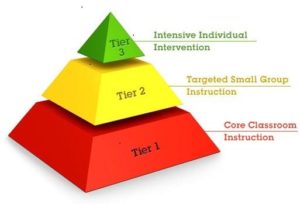Levels of Support for Students – MTSS and RtI
Educational programs and supports are constantly evolving to support more individualized needs of students. One of the more recent initiatives within schools are MTSS and RtI.
Responsiveness to Intervention (RtI) was developed as part of the reauthorization of the Individuals with Disabilities Act (IDEA) in 2004. The model was developed as educators recognized that some struggling students might respond to some short-term intensive supports or services without the need for long-term special education services and accommodations. Under RtI, teachers and other support staff could modify instruction to support students who were identified as struggling or at risk of failing. It aligns with the concept of Least Restrictive Environment (LRE) which aims to offer students adequate support, but not any more than what is needed.

The RtI model later led to an approach called Multi-tiered System of Supports (MTSS). This is a general education initiative, meaning it is not limited only to students who are struggling, underperforming, or diagnosed with disabilities. It is a model intended to support ALL students; to enhance and ensure effective core instruction in all classrooms, to provide early identification of students who need supports, and to facilitate the process of identifying students with special education needs.
MTSS is best represented by a pyramid. At the base is the majority of students who receive universal supports in the classroom. In the middle, a small percentage of students receive targeted, short-term intervention; data is collected to determine their “responsiveness” to the supports. At the top, the smallest percentage of students are identified as needed special education services, such as those diagnosed with a disability.
MTSS and RtI can be implemented for any related service in a school. Below will outline some examples specific to school social work and speech language pathology services in schools.
School Social Work

- Tier 1: universal screenings for behavioral and emotional barriers, integrate social emotional learning into classroom, educate staff on identification of mental health concerns and referral process, school wide positive behavioral interventions and supports (PBIS) program
- Tier 2: individual and group counseling, development and monitoring of student behavior intervention plans (check-in, check-out), suicide risk assessment
- Tier 3: formal evaluations, direct therapeutic services, crisis intervention/response, IEP plans, functional behavior assessment/behavior intervention plans (FBA/BIP)
Speech Language Pathology
- Tier 1: providing information to other school staff on how to recognize communication difficulties/delays, plan and implement universal screenings
- Tier 2: observe students identified as struggling in the classroom, provide strategies for teachers to implement in the classroom, conduct formal screenings, implement short term intervention plans for specific challenges (i.e. articulation errors) and track data
- Tier 3: formal evaluations, direct therapeutic services, IEP plans
This just scratches the surface of how MTSS is implemented in schools, and programs may vary from one district to another. The next steps to the process of understanding MTSS are:
- Find the MTSS team within your school building or district
- Talk to colleagues within your district about forms, procedures, and school-specific protocols
- Search your professional organizations (such as ASHA or the SSWAA) for the most up-to-date evidence based practices for your field







